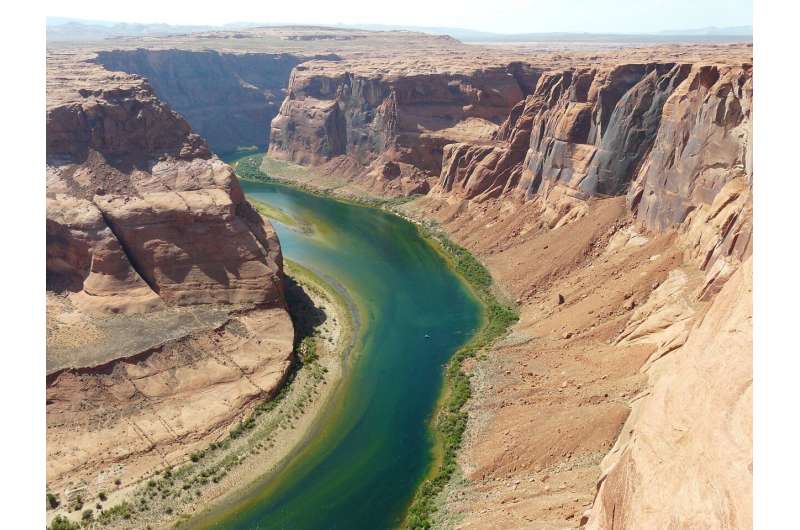New push to shore up shrinking Colorado River could reduce water flow to states

With the Colorado River reservoirs continuing to decline, federal officials announced plans Friday to revise their current rules for dealing with shortages and will pursue a new agreement to achieve larger reductions in water use throughout the Southwest.
The announcement by the Biden administration represents a renewed push in trying to scale back water use along the river to bring demands more into line with supply in the face of a 23-year megadrought worsened by global heating.
The Interior Department said with the water level dropping at Lake Powell, operations may need to change at Glen Canyon Dam to release less water, affecting downstream flows in the Grand Canyon and accelerating the decline of Lake Mead. The department said to protect public health and safety and the integrity of the system, releases from Hoover Dam may also need to be reduced—which would shrink the amounts of water flowing to California, Arizona and Mexico.
Federal officials in June called for the seven states that rely on the Colorado River to come up with plans to drastically reduce annual water diversions by about 15% to 25% regionwide. But negotiations among the states grew tense and acrimonious, and didn't produce a deal.
The Interior Department has the authority to step in and unilaterally impose larger cuts. But federal officials appear to be trying to push for consensus on shrinking the water take from the river rather than dictating reductions in ways that could further inflame tensions or lead to legal fights.
"The Interior Department continues to pursue a collaborative and consensus-based approach to addressing the drought crisis afflicting the West," Interior Secretary Deb Haaland said in a news release. "At the same time, we are committed to taking prompt and decisive action necessary to protect the Colorado River System and all those who depend on it."
Water from the Colorado River is used by about 40 million people, flowing to cities, farmlands and tribal nations from the Rocky Mountains to Southern California. The river has long been over-allocated. So much water is diverted that the river's delta in Mexico largely dried up decades ago.
Lake Mead and Lake Powell, the river's two largest reservoirs, now sit nearly three-fourths empty. Declining water levels are putting the dams' ability to generate hydropower at risk.
Without major cuts in water use, the latest projections show growing risks of the reservoirs approaching "dead pool" levels, where water would no longer pass downstream.
The current system for dealing with shortages was established in operating rules dating to 2007, and a 2019 deal laid out a series of additional cutbacks as Lake Mead's levels decline.
The federal Bureau of Reclamation said it will publish a notice to prepare a "supplemental environmental impact statement," which will include proposed alternatives for revising the 2007 rules. Those rules, called the interim guidelines, are set to expire after 2026, and negotiations on the next round of shortage-sharing rules have yet to begin.
The Interior Department said officials will consider alternatives for revising the current rules to "provide additional alternatives and measures needed to address the likelihood of continued low-runoff conditions."
2022 Los Angeles Times.
Distributed by Tribune Content Agency, LLC.





















